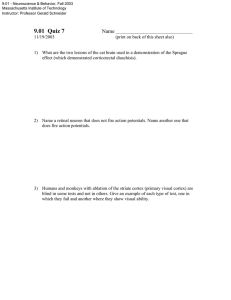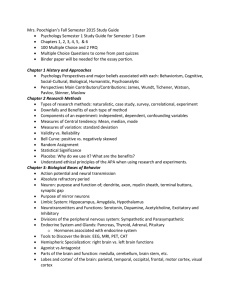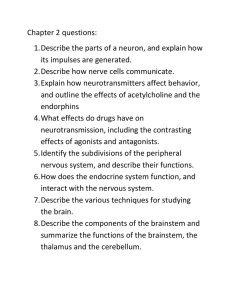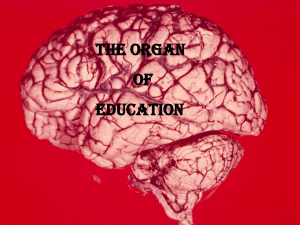9.01 - Neuroscience & Behavior Fall 2003 Massachusetts Institute of Technology
advertisement
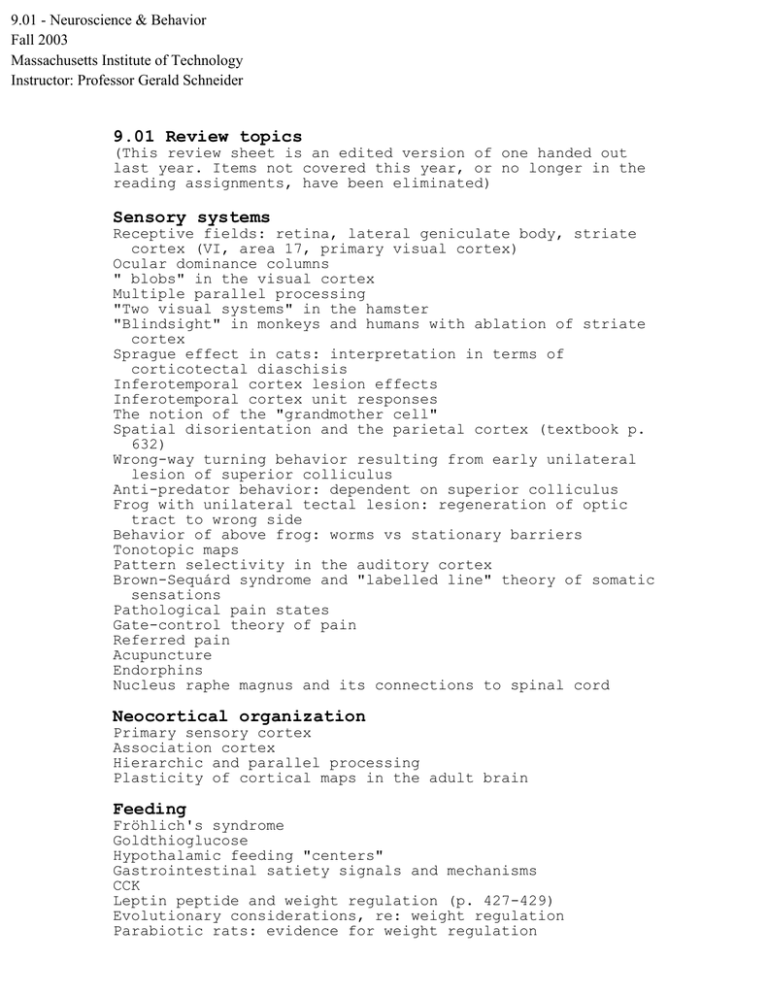
9.01 - Neuroscience & Behavior Fall 2003 Massachusetts Institute of Technology Instructor: Professor Gerald Schneider 9.01 Review topics (This review sheet is an edited version of one handed out last year. Items not covered this year, or no longer in the reading assignments, have been eliminated) Sensory systems Receptive fields: retina, lateral geniculate body, striate cortex (VI, area 17, primary visual cortex) Ocular dominance columns " blobs" in the visual cortex Multiple parallel processing "Two visual systems" in the hamster "Blindsight" in monkeys and humans with ablation of striate cortex Sprague effect in cats: interpretation in terms of corticotectal diaschisis Inferotemporal cortex lesion effects Inferotemporal cortex unit responses The notion of the "grandmother cell" Spatial disorientation and the parietal cortex (textbook p. 632) Wrong-way turning behavior resulting from early unilateral lesion of superior colliculus Anti-predator behavior: dependent on superior colliculus Frog with unilateral tectal lesion: regeneration of optic tract to wrong side Behavior of above frog: worms vs stationary barriers Tonotopic maps Pattern selectivity in the auditory cortex Brown-Sequárd syndrome and "labelled line" theory of somatic sensations Pathological pain states Gate-control theory of pain Referred pain Acupuncture Endorphins Nucleus raphe magnus and its connections to spinal cord Neocortical organization Primary sensory cortex Association cortex Hierarchic and parallel processing Plasticity of cortical maps in the adult brain Feeding Fröhlich's syndrome Goldthioglucose Hypothalamic feeding "centers" Gastrointestinal satiety signals and mechanisms CCK Leptin peptide and weight regulation (p. 427-429) Evolutionary considerations, re: weight regulation Parabiotic rats: evidence for weight regulation Metabolic effects explaining hypothalamic hyperphagia Vagotomy and hypothalamic hyperphagia Paraventricular nucleus Conditioned taste aversion (Garcia effect, p. 423) Sleep and circadian rhythms Stages of sleep: two major ones Circadian clock Free-running activity cycles Transplants of Suprachiasmatic nucleus Dreaming and sleepwalking re: sleep stages Biological functions of sleep Sleep deprivation studies (testing the theories) Brain lesions that affect sleep: examples Suprachiasmatic nuclei Sleep disorders: sleep apnea, narcolepsy, cataplexy, insomnia Hormones and sex Sexual dimorphism in hypothalamus (p. 390-393) Aromatization and brain masculinization (p. 389-390) Alpha fetoprotein Memory Short-term memory; long-term memory Consolidation Hebb's theory of memory formation; Hebbian synapses Patient H.M. - lesion and symptoms Retrograde amnesia Anterograde amnesia Explicit and implicit memory: examples Declarative and non-declarative (procedural) memory (alternative terms for the above) Korsakoff's syndrome; diencephalic amnesia Memory deficits in Alzheimer's disease Animal models of amnesia Place cells in hippocampus Long-term potentiation Language and lateralization of function; disconnection syndromes Aphasias: Broca's, Wernicke's, conduction Alexia and agraphia Wernicke-Geschwind model of language mechanisms; criticisms Planum temporale PET scans and language localization (Note assumptions being made) Cerebral dominance and how it is detected: in neurological patients; in normal people Language in "split brain" patients Cross cuing Visual completion in split brain patients Role of corpus callosum in reading, or in visual object naming Limbic system; emotions; "mental" illness Electrically elicited aggression in cats: two types Appetitive vs consummatory behavior Biting attack: hypothalamic modulation of hindbrain reflexes Klüver-Bucy syndrome Polygraphic recordings used for "lie detection" Facial expressions of emotion; deception Conditioned fear and the amygdala Androgens and aggressive behavior Electrical stimulation of amygdala in man; cf. drug states Dopamine hypothesis of schizophrenia Neuroleptics Concordance rates: examples and meaning (p. 506-508) Monoamine hypothesis of depression; criticism of it (p. 519f) Dissociated memory states in human pathological conditions Dissociation between human language systems and consciousness? Human instinct for perception of unified self: relation to cross cuing, and confabulation by split-brain patients
